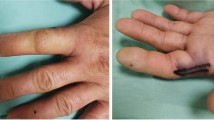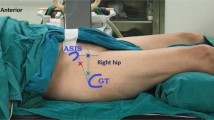Abstract
This review on joint aspiration and injection focuses on three common clinical problems: how to deal with 'dry taps', especially when a septic joint is suspected in the differential diagnosis; how to avoid rare complications associated with these techniques; and how to reduce pain in patients who are particularly sensitive. Solutions to these problems are proposed, and although no new data or insights are provided, this article could be used as a noncomprehensive check list for trainee rheumatologists. This review focuses on the knee, because of the common appearance of septic joints in the differential diagnosis of inflammatory knee effusion, and the paramount importance of septic joints in this setting. The five reasons for failing to aspirate fluid from a difficult knee joint that are discussed here could be applied to other more problematic joints, such as the elbow or ankle. Some additional time-consuming techniques involving more than one syringe and two operators might not be cost effective in many situations, but these should be taught for use in selected cases in which pain hinders aspiration. Training should also be provided to ensure that rheumatologists never inject against pressure, and that they switch to the lateral approach when aspirating the knee if their first attempt fails, especially if a septic joint is suspected and fluid must be obtained for diagnosis.
Key Points
-
The knee is the archetypal joint for rheumatology trainees to study when trying to understand why some joints with apparent effusion fail to yield to attempts at aspiration
-
Five reasons for this 'dry tap' scenario in knees have been well described by MRI studies
-
When facing a dry tap of a potentially septic knee, switch the approach from the medial to the lateral side of the knee
-
A variety of more complex techniques (involving two syringes or two operators) can be used in selected cases to reduce rare complications and the pain of aspiration and injection
This is a preview of subscription content, access via your institution
Access options
Subscribe to this journal
Receive 12 print issues and online access
$209.00 per year
only $17.42 per issue
Buy this article
- Purchase on Springer Link
- Instant access to full article PDF
Prices may be subject to local taxes which are calculated during checkout








Similar content being viewed by others
References
Roberts WN et al. (1996) Dry taps and what to do about them: a pictoral essay on failed arthrocentesis of the knee. Am J Med 100: 461–464
Ropes MW and Bauer W (1953) Synovial fluid changes in joint disease. Cambridge, MA: Harvard University Press
Hollander JL et al. (1951) Hydrocortisone and cortisone injected into arthritic joints: comparative effects of and use of hydrocortisone as a local antiarthritic agent. JAMA 147: 1629–1635
Hetland ML et al. (2006) Combination treatment with methotrexate, cyclosporine, and intraarticular betamethasone compared with methotrexate and intraarticular betamethasone in early active rheumatoid arthritis: an investigator-initiated, multicenter, randomized, double-blind, parallel-group, placebo-controlled study. Arthritis Rheum 54: 1401–1409
Qvistgaard E et al. (2006) Intra-articular treatment of hip osteoarthritis: a randomized trial of hyaluronic acid, corticosteroid, and isotonic saline. Osteoarthritis Cartilage 14: 163–170
Evans CH et al. (2006) Gene therapy for arthritis: what next? Arthritis Rheum 54: 1714–1729
Evans CH et al. (2005) Gene transfer to human joints: progress toward a gene therapy of arthritis. Proc Natl Acad Sci USA 102: 8698–8703
Ijima K et al. (2001) Successful gene therapy via intraarticular injection of adenovirus vector containing CTLA4IgG in a murine model of type II collagen-induced arthritis. Hum Gene Ther 12: 1063–1077
Chevalier X et al. (2005) Safety study of intraarticular injection of interleukin 1 receptor antagonist in patients with painful knee osteoarthritis: a multicenter study. J Rheumatol 32: 1317–1323
Conti F et al. (2005) Successful treatment with intraarticular infliximab for resistant knee monarthritis in a patient with spondylarthropathy: a role for scintigraphy with 99mTc-infliximab. Arthritis Rheum 52: 1224–1226
Schatteman L et al. (2006) Treatment of refractory inflammatory monoarthritis in ankylosing spondylitis by intraarticular injection of infliximab. J Rheumatol 33: 82–85
Sparling M et al. (1990) Radiographic followup of joints injected with triamcinolone hexacetonide for the management of childhood arthritis. Arthritis Rheum 33: 821–826
Sherry DD et al. (1999) Prevention of leg length discrepancy in young children with pauciarticular juvenile rheumatoid arthritis by treatment with intraarticular steroids. Arthritis Rheum 42: 2330–2334
Roberts WN et al. (1996) Corticosteroid injection in rheumatoid arthritis does not increase rate of total joint arthroplasty. J Rheumatol 23: 1001–1004
Gelse K et al. (2003) Articular cartilage repair by gene therapy using growth factor-producing mesenchymal cells. Arthritis Rheum 48: 430–441
Evans CH and Robbins PD (1999) Potential treatment of osteoarthritis by gene therapy. Rheum Dis Clin North Am 25: 333–344
van de Loo FA et al. (2002) Gene therapy for rheumatoid arthritis. Lessons from animal models, including studies on interleukin-4, interleukin-10, and interleukin-1 receptor antagonist as potential disease modulators. Rheum Dis Clin North Am 28: 127–149
Committee on Rheumatologic Care (1999) Benchmarks in Rheumatology Practice. Data from the 1999 American College of Rheumatology Economic Survey. Atlanta: American college of Rheumatology
Abeles M and Garjian P (1986) Do spray coolant anesthetics contaminate an aseptic field? Arthritis Rheum 29: 576
Cawley PJ and Morris IM (1992) A study to compare the efficacy of two methods of skin preparation prior to joint injection. Br J Rheumatol 31: 847–848
Charalambous CP et al. (2003) Septic arthritis following intra-articular steroid injection of the knee—a survey of current practice regarding antiseptic technique used during intra-articular steroid injection of the knee. Clin Rheumatol 22: 386–390
Roberts WN and Hauptman HW (2007) Intra-articular and soft tissue steroid injections: complications. In Rheumatology Up to Date CD Rom (Ed. PH Schur) Waltham, MA: UpToDate, Inc.
Hollander JL (1961) Intrasynovial corticosteroid therapy: a decade of use. Bull Rheum Dis 11: 239–240
Centeno LM and Moore ME (1994) Preferred intraarticular corticosteroids and associated practice: a survey of members of the American College of Rheumatology. Arthritis Care Res 7: 151–155
Sweetnam R (1969) Corticosteroid arthropathy and tendon rupture. J Bone Joint Surg Br 51: 397–398
Gottlieb NL and Riskin WG (1980) Complications of local corticosteroid injections. JAMA 243: 1547–1548
Sibbitt W et al. (2006) Physician control of needle and syringe during aspiration-injection procedures with the new reciprocating syringe. J Rheumatol 33: 771–778
Kloen P et al. (1998) Lipoma arborescens of the knee. J Bone Joint Surg Br 80: 298–301
Grassi W et al. (2001) Sonographically guided procedures in rheumatology. Semin Arthritis Rheum 30: 347–353
Koski JM (2000) Ultrasound guided injections in rheumatology. J Rheumatol 27: 2131–2138
d'Agostino MA et al. (2005) Impact of ultrasound imaging on local corticosteroid injections of symptomatic ankle, hind-, and mid-foot in chronic inflammatory diseases. Arthritis Rheum 53: 284–292
Naredo E et al. (2004) A randomized comparative study of short term response to blind injection versus sonographic-guided injection of local corticosteroids in patients with painful shoulder. J Rheumatol 31: 308–314
Raza K et al. (2003) Ultrasound guidance allows accurate needle placement and aspiration from small joints in patients with early inflammatory arthritis. Rheumatology (Oxford) 42: 976–979
Margules KR (2001) Fluoroscopically directed steroid instillation in the treatment of hip osteoarthritis: safety and efficacy in 510 cases. Arthritis Rheum 44: 2449–2450
Leopold SS et al. (2001) Safety and efficacy of intraarticular hip injection using anatomic landmarks. Clin Orthop Related Res 391: 192–197
Anderson, BC (2005) Guide to Arthrocentesis and Soft Tissue Injection, 132. Philadelphia: Elsevier Saunders
Jackson DW et al. (2002) Accuracy of needle placement into the intra-articular space of the knee. J Bone Joint Surg Am 84A: 1522–1527
Ostensson A and Geoborek P (1991) Septic arthritis as a non-surgical complication in rheumatoid arthritis: relation to disease severity and therapy. Br J Rheumatol 30: 35–38
Courtney P and Doherty M (2005) Joint aspiration and injection. Best Pract Res Clin Rheumatol 19: 345–369
Biundo JJ (2005) It hurts whenever I do this: common musculoskeletal complaints. American College of Physicians annual meeting CD series: 2005 April 14–16; San Francisco
Acknowledgements
CW Wise, MD, Irby Professor of Rheumatology, Virginia Commonwealth University provided an updated reference database. Professor CW Hayes MD, Bone Radiology Section Chief, Medical College of Virginia Hospital, Virginia Commonwealth University provided the images.
Author information
Authors and Affiliations
Ethics declarations
Competing interests
The author has been a speaker for Bristol-Myers Squibb, for which he has received less than $10,000 per year. Also, please note that reference 8 of this review describes use of an injectable gene therapy, the protein product of which is part of a Bristol Meyers-Squibb biologic agent.
Rights and permissions
About this article
Cite this article
Roberts, W. Primer: pitfalls of aspiration and injection. Nat Rev Rheumatol 3, 464–472 (2007). https://doi.org/10.1038/ncprheum0558
Received:
Accepted:
Issue Date:
DOI: https://doi.org/10.1038/ncprheum0558
This article is cited by
-
Clinical examination, ultrasound assessment and aspiration of knee effusion in primary knee osteoarthritis patients
Journal of Orthopaedic Surgery and Research (2023)
-
Likelihood of hip infection with image-guided hip aspiration dry tap: a 10-year retrospective study
Skeletal Radiology (2022)
-
Extractable synovial fluid in inflammatory and non-inflammatory arthritis of the knee
Clinical Rheumatology (2019)
-
Improvement in diagnostic and therapeutic arthrocentesis via constant compression
Clinical Rheumatology (2018)
-
The outcomes and cost-effectiveness of intraarticular injection of the rheumatoid knee
Rheumatology International (2012)



